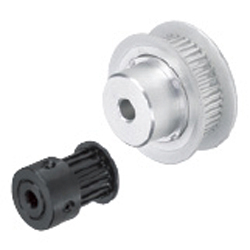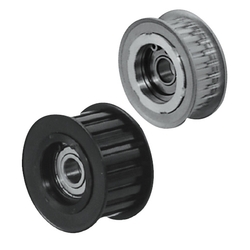(!)NOTE : Windows 7 users won’t be able to use some latest features of eCatalog/WOS since Microsoft is ending support for Windows 7 on 14 Jan, 2020. Please upgrade your system for uninterrupted services.
- Scheduled Maintenance Notice: This site will be unavailable due to scheduled maintenance from 6:30 24/11/2024 to 4:30 (IST) 25/11/2024. We apologize for the inconvenience.
- Please note that the MISUMI Pune office and warehouse will be closed on November 20th due to the state election.
- Notice of End of Sales for Economy Series Pneumatic Equipment Category. More information.
MISUMI Timing Pulleys, Idlers(Belt Series:P2M)
|
Type
|
|
|---|---|
Brand |
|
| CAD |
|
| Days to Ship |
|
2 items
- Sort By
-
You can add up to 6 items per a category to the compare list.

High Torque Timing Pulleys P2M/P3M Type
MISUMI
[Material]
· Pulley: High strength aluminum alloy, S45C equivalent, SUS304
· Flange: Aluminum alloy, SPCCType Belt Series Belt Width Used (mm)(mm) Number of Teeth(T) Pulley Shape Material Belt Width Used(Inch)(Inch) Surface Treatment Timing Pulley P2M 6 14 ~ 60 Shape A / Shape B / Shape C Aluminum - Clear Anodize Days to Ship: 8 Day(s) or more  8 Day(s) or more
8 Day(s) or more
-
You can add up to 6 items per a category to the compare list.

Flanged Idlers with Teeth - P2M, P3M, P5M, P8M - Center Bearing
MISUMI
It can be used for timing belt tension adjustment and driven pulley.
[Material]
· Pulley: Aluminum alloy, extra super duralumin aluminum alloy, S45C equivalent
· Flange: Aluminum alloy, SPCC
· Bearing: Steel
[Surface treatment]
· Clear anodize, black oxide- Volume Discount
Type Belt Series Belt Width Used (mm)(mm) Number of Teeth(T) Pulley Shape Material Belt Width Used(Inch)(Inch) Surface Treatment Idler with Teeth P2M 6 40 - Aluminum - Clear Anodize From: ₹ 2,941.48 Days to Ship: 8 Day(s) or more  8 Day(s) or more
8 Day(s) or more
| Brand |
|---|
| Product Series |
| CAD |
| From |
| Days to Ship |
| Type |
| Belt Series |
| Belt Width Used (mm)(mm) |
| Number of Teeth(T) |
| Pulley Shape |
| Material |
| Belt Width Used(Inch)(Inch) |
| Surface Treatment |
You can add up to 6 items per a category to the compare list. | You can add up to 6 items per a category to the compare list. | |
| Brand | MISUMI | MISUMI |
| Product Series | Flanged Idlers with Teeth - P2M, P3M, P5M, P8M - Center Bearing | |
| CAD |
|
|
| From | - | ₹ 2,941.48 |
| Days to Ship | 8 Day(s) or more | 8 Day(s) or more |
| Type | Timing Pulley | Idler with Teeth |
| Belt Series | P2M | P2M |
| Belt Width Used (mm)(mm) | 6 | 6 |
| Number of Teeth(T) | 14 ~ 60 | 40 |
| Pulley Shape | Shape A / Shape B / Shape C | - |
| Material | Aluminum | Aluminum |
| Belt Width Used(Inch)(Inch) | - | - |
| Surface Treatment | Clear Anodize | Clear Anodize |
Loading...
Configure
Specification/Dimensions
-
Belt Series
-
Belt Width Used (mm)(mm)
-
Number of Teeth(T)
-
Pulley Shape
-
Material
- Steel
- Aluminum
- Stainless Steel
- Plastic
-
Belt Width Used(Inch)(Inch)
-
Surface Treatment
Narrow search by specifying Manufacturer
-
- MISUMI (2)
- KONISHI (0)
- MITSUBOSHI BELTING (0)
- UNITTA (0)
- NABEYA BI-TECH (0)
- KATAYAMA CHAIN (0)
Related Categories to Timing Pulleys, Idlers
FAQ's Timing Pulleys, Idlers
- Question: What are timing pulleys and idlers?
- Answer: Timing pulleys are wheels with teeth that engage with the teeth on a timing belt to transmit power and synchronize the rotation of two shafts. Idlers are pulleys that support the timing belt and help to maintain tension.
- Question: What are the different types of timing pulleys and idlers?
- Answer:
There are many different types of timing pulleys and idlers available, depending on the application. Some common types include:
Timing pulleys: Synchronous pulleys, HTD pulleys, AT pulleys, and XL pulleys.
Idlers: Flanged idlers, flat idlers, and spring-loaded idlers.
- Question: What are the factors to consider when choosing timing pulleys and idlers?
- Answer: When choosing timing pulleys and idlers, it is important to consider the following factors:
Belt type: The type of timing belt that will be used.
Belt width: The width of the timing belt.
Number of teeth: The number of teeth on the timing belt
Pulley shape: The shape of the timing pulley (e.g., straight-tooth, curved-tooth, or flanged).
Material: The material of the timing pulley and idler (e.g., steel, aluminum, or plastic).
Surface treatment: The surface treatment of the timing pulley and idler (e.g., black oxide, zinc plating, or nickel plating).
- Question: What are the benefits of using timing pulleys and idlers?
- Answer: Timing pulleys and idlers offer a number of benefits, including:
Positive power transmission: Timing pulleys and idlers provide positive power transmission, meaning that the timing belt cannot slip. This is important for applications where precise synchronization is required.
Low maintenance: Timing pulleys and idlers require very little maintenance. The timing belt is the only component that needs to be replaced periodically.
Long service life: Timing pulleys and idlers have a long service life, making them ideal for demanding applications. - Question: What are some common applications of timing pulleys and idlers?
- Answer: Timing pulleys and idlers are used in a wide variety of applications, including:
Industrial automation: Timing pulleys and idlers are used in industrial automation systems to transmit power and synchronize the rotation of different shafts.
Manufacturing: Timing pulleys and idlers are used in manufacturing processes to drive conveyors, machine tools, and other equipment.
Automotive: Timing pulleys and idlers are used in automotive engines to drive the camshaft and other components.
Aerospace: Timing pulleys and idlers are used in aerospace applications to drive pumps, fans, and other critical components. - Question: How do I install timing pulleys and idlers?
- Answer: To install timing pulleys and idlers, follow these steps:
Mount the timing pulleys on the shafts.
Install the timing belt on the pulleys.
Adjust the tension of the timing belt.
Install the idlers. - Question: How do I maintain timing pulleys and idlers?
- Answer: The only maintenance required for timing pulleys and idlers is to inspect the timing belt for wear and tear. If the timing belt is worn or damaged, it should be replaced immediately.
- Question: What are some common problems with timing pulleys and idlers?
- Answer: Some common problems with timing pulleys and idlers include:
Belt wear and tear: The timing belt is the only component that needs to be replaced periodically. The rate of wear and tear will depend on the application and the environment in which the timing belt is operating.
Misalignment: If the timing pulleys are not misaligned, it can cause the timing belt to wear prematurely.
Corrosion: Corrosion can damage the timing pulleys and idlers, reducing their service life. - Question: How do I troubleshoot problems with timing pulleys and idlers?
- Answer:
If you are experiencing problems with your timing pulleys and idlers, you can try the following troubleshooting steps:
Inspect the timing belt for wear and tear. If the timing belt is worn or damaged, it should be replaced immediately.
Check the alignment of the timing pulleys. If the pulleys are not aligned, they should be adjusted.
Inspect the timing pulleys and idlers for corrosion. If the pulleys and idlers are corroded, they should be cleaned and protected. - Question: Why are pulleys better than gears?
- Answer:
1.Simplicity installation : Pulleys have a simpler design and operation compared to gears. They consist of a grooved wheel and a belt, making them easier to install, and maintain. Gears, on the other hand, require precise tooth profiles and arrangements, adding complexity.
2.Noise and Vibration: Pulleys generally produce less noise and vibration compared to gears. The direct contact between gear teeth can create noise, particularly at high speeds. In contrast, pulleys that use a belt or rope for motion transfer offer smoother operation, resulting in reduced noise and vibration levels.
3.Misalignment Tolerance Available: Pulleys can accommodate a certain degree of misalignment between the driving and driven shafts. This flexibility is valuable in situations where precise alignment is challenging. Gears, on the other hand, require more precise alignment for optimal performance and can be sensitive to misalignment.
4.Overload Protection: Pulleys can provide some level of overload protection due to the slipping action of the belt. If the load exceeds a certain threshold, the belt may slip on the pulley, preventing damage to the system. Gears do not offer this slipping action and are more prone to damage when subjected to excessive loads.
It's important to recognize that gears have their own advantages, such as higher precision, greater efficiency, and the ability to transmit higher torque loads. The choice between pulleys and gears depends on the specific requirements of the application, including factors like load capacity, precision, speed control, and cost considerations.



















How can we improve?
How can we improve?
Thank you for your time.
Your feedback is essential for our continuous improvement
Privacy Policy
Thank you for your cooperation.
Thank you for your time.
Your feedback is essential for our continuous improvement
Please use the inquiry form.
Privacy Policy